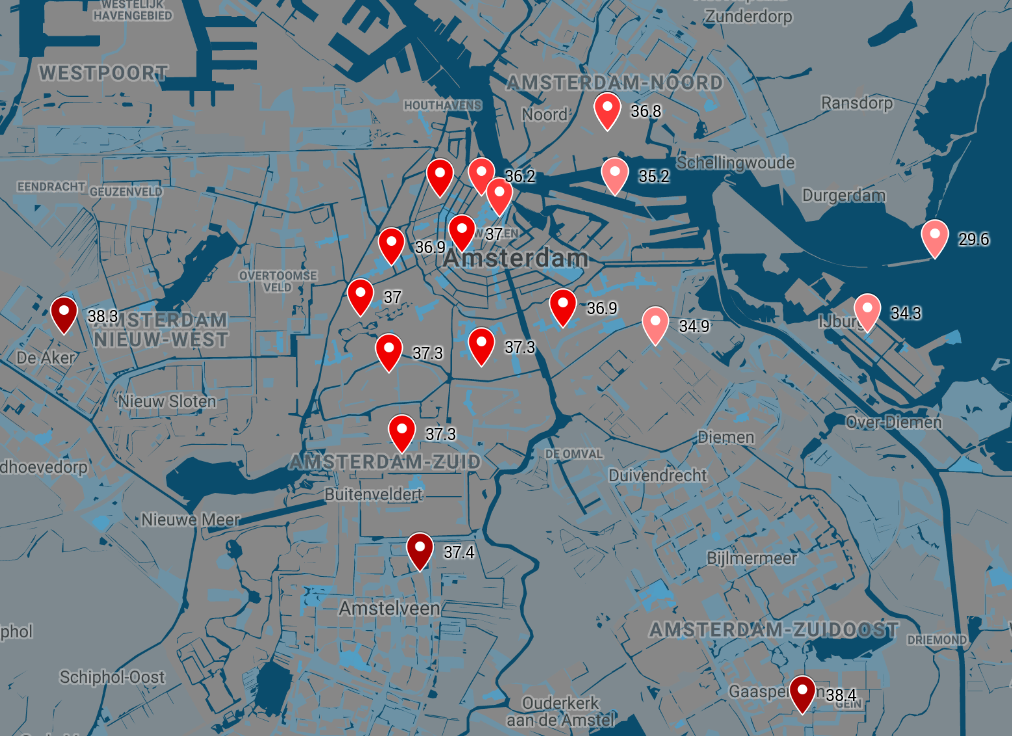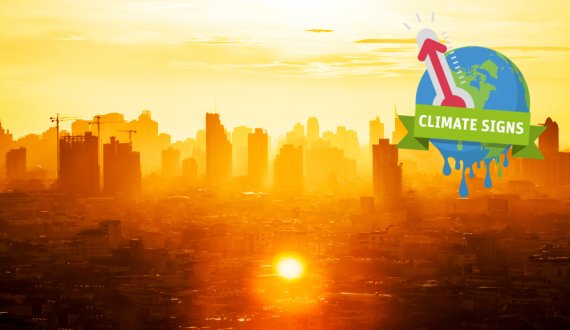Photo: Shutterstock
| "Climate signs" | Climate change is not about the future — it is happening now and we can already see the effects. In its “Climate Signs” series, Resource will be looking over the summer at how climate change affects people’s daily lives all around the world and what WUR researchers are doing about this issue. |
|---|
Why are heat islands such a hot topic?
‘Large metropoleis, like those in Asia and the United States, have been dealing with this phenomenon for some time already. We did not expect to be bothered by this in the Netherlands because of our mild climate. And our cities weren’t built to handle it either. It wasn’t until the big heat waves of 2003 and 2006 that changes took place. More heat waves are expected to occur in the future. In combination with the ever-increasing urbanisation, these will cause increased heat stress in cities.’

Air conditioning pumps out more hot air, so if we all turn on the air conditioning, the city will become even hotter.
Gert-Jan Steenveld, researcher at the Meteorology and Air Quality group
| What do we consider to be a heat wave? | In the Netherlands, a heat wave is a sequence of at least five ‘summery’ days in De Bilt (maximum temperatures of 25.0 °C or higher), of which at least three are ‘tropical’ days (maximum temperatures of 30.0 °C or higher). Source: Royal Netherlands Meteorological Institute (KNMI) |
|---|
To what extent is this related to climate change?
‘It is difficult to immediately link a specific hot day to climate change. The KNMI climate scenarios predict that both the average temperature and the extremes will increase. Many climate analyses are based on measurements in De Bilt, as that is the location with the longest Dutch measurement series. However, before the 1950s, we employed other instruments and setups here, which used different measuring principles than current instruments.’
Does that allow for a good comparison?
‘To avoid comparing apples and oranges, all measurements taken before the 1950s have been corrected. This has also led to those measurements turning out cooler, which revealed that there were fewer heat waves in those years. Climate sceptics sometimes cite this as an argument, saying this was done intentionally to create the appearance of a more significant increase in the number of heat waves. We are confident that KNMI has done this properly, following the scientific methods that are currently accepted.’
What causes this heat island effect?
‘Measurements show that temperatures in the city can be up to eight degrees higher than in the countryside. But that can also vary considerably within a city, per street even. The fact that cities retain heat is partly due to buildings. Due to the height and density of the buildings, the heat cannot escape as easily at night; radiation does this most efficiently when it can spread in all directions. In addition, other factors also come into play: cities have a lot of traffic and activity that also generate heat. On top of that, there is usually less vegetation that could provide cooling. The effects of heat islands are most significant at night, because the dark asphalt, concrete and stones store a lot of heat, which they radiate at night. This prevents the city from cooling down sufficiently at night.’
We can calculate scenarios and help urban planners determine how they can best plan the city to keep it cool.
What are the consequences?
‘Heat stress also forms a serious health hazard. According to calculations by Statistics Netherlands (CBS), 300 more people died during the week of the 2003 heat wave than during an average week at the start of summer. Especially vulnerable groups such as the elderly and the chronically ill run greater risk. In addition, the heat reduces labour productivity and can lead to sleep problems. The body can handle heat fairly well, provided it can recover at night, but that doesn’t work during such a heat wave. Smog also causes more problems during heat waves, because there is often a high-pressure area in which the air drops, thus creating a kind of lid over the city, under which all the dirty air and also ozone are caught. This is particularly harmful to the respiratory tract.’

Maximum temperaturen op verschillende plekken in Amsterdam. Gemeten op 25 juli 2019. Bron: Amsterdam Atmospheric Monitoring Supersite
How can we accurately predict the city climate, and why is that important?
Normal weather model calculations are made at a resolution of 9 kilometres. Amsterdam would only be a single point on the grid. We [WUR and Amsterdam Institute for Metropolitan Solutions, ed.] use a high-resolution database, which is accurate up to 100 metres, and calculate the influence of aspects such as buildings, vegetation, water, wind and shade on the local temperature. We have now done this for Amsterdam. This allows us to calculate various things, like where shadow falls in a street and at what time and where cool places are due to vegetation, for example. With these kinds of predictions, the government and health services can take timely measures and better prepare for heat stress. We can also calculate scenarios and help urban planners determine how they can best plan the city to keep it cool, for example.’
Why not make such a detailed forecast for the entire Netherlands?
‘Well, we have the advantage that the geographical information regarding urban land use in Netherlands is known down to the centimetre. However, it would cost too much computer power at the moment. It would take a week to yield such a weather forecast. But we did create a weather-experience application that people can use on their smartphone to look up where it is cooler.’
What measures could we take to make it more bearable in the city?
‘We have seen that more vegetation helps. But that also means it must survive a dry spell, because wilted grass has an effect very similar to that of stone. Buildings could also be made to reflect more radiation, for example with white roofs. And tall buildings also provide more shade in the streets. This is often done in southern European cities, where the narrow streets and densely built houses provide cooling in the street.’
What about water?
‘We have also investigated the effect of water, but that is more complicated. Fountains help if they create a mist. However, large water bodies have a very delayed effect; they do limit the warming during the day, but with cool slower at night. What would mainly help people is to keep everything closed, and to cool at night – but only if the outside temperature is lower than that in the house. Air conditioning pumps out more hot air, so if we all turn on the air conditioning, the city will become even hotter.’
Additional reading:
Weather balloons map Amsterdam’s city climate
From giant ticks to super-ants: invasive species are on their way
Himalayan meltwater is crucial for millions of farmers

